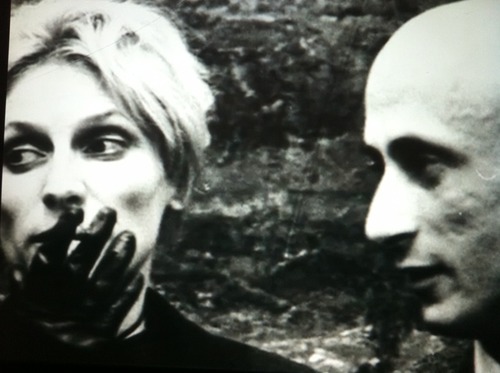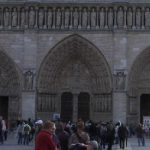Special Feature: A Conversation with Chiara Clemente and Swoon
Suzan Sherman: You begin your documentary with a quote from Susan Sontag: “I was not looking for my dreams to interpret life, but rather for my life to interpret my dreams.” These words fittingly reflect the women that you’ve featured in Our City Dreams, who, like Sontag, came to New York to be artists. How did you come up with this idea as the premise of your film, and to focus on women artists in particular?
Chiara Clemente: I grew up mostly in New York City, but at 18 I decided to leave and thought that I would never return except to visit. As a New Yorker I believe you either love this crazy city or you have to escape—there is really no in between—and I was the type that had to leave. It took eight years, four in L.A. and another four in Rome, to realize that New York was more a part of me then I had realized. When I finally decided to come back I knew that the best way for me to rediscover the city was through my camera.
The idea really started with wanting to do a portrait of New York. I had been working on films about artists in Italy so the subject matter was an obvious choice. I decided to focus on women because I felt that I could be closer to the subject and it would be more personal. Before I left New York at 18 I had made a film focusing on boys, and on my return I decided to pick women…I think that it says something about my interests, then and now.
SS: Swoon starts off your documentary—and you move through the lives of each artist separately and in accordance with their increasing age, beginning with 30 and ending at 80. How did you decide to make this the structure for your film, instead of beginning, say, with Nancy Spero, or cutting back and forth between the five artists?
CC: Although the film is made up of five separate very intimate portraits, it was extremely important to me that it be one story. The story of an artist, a woman coming to New York to make her dreams come true, and the different stages of this artist’s life and work over time.
SS: Can you speak about your choices for incorporating music and sound (even Allen Ginsberg reciting his poetry) into your film?
CC: In my films I always love to add different layers and textures. I use different mediums—16mm, super 8, disposable video cameras—as well as music and sound elements. Music is such a big part of a film and it can really carry you through a story. From the very beginning of making this film it was important that I find a composer who could help connect the stories of the five women. I always loved Thomas Lauderdale and Pink Martini and was amazed at how different their sounds could be but still fit seamlessly together.
SS: You included a great piece of footage, which you presumably filmed, of Kiki Smith unscrewing drawer pulls from a bureau that had been left out on the street. Afterward she rides off with the hardware on her bike. You also filmed Ghada Amer’s opening, Swoon pasting her artwork up on billboards, Marina Abramovic backstage before a performance at the Guggenheim, and Nancy Spero’s 80th birthday party with her family. It’s a lot of work tracking five very well-known artists and their careers. Give us a glimpse of how you were able to juggle this, as well as be permitted into their otherwise very private world.
CC: I felt like I had six lives for two years—the five artists and myself. It was like being a doctor on call. I would be checking in with the artists and all of a sudden find myself jumping on a plane or a train and meeting them somewhere. One day while filming Marina at the Guggenheim I was opening the door, and she turned to me and asked if I wanted to come to Thailand with her—one week later I was on a plane heading halfway around the world. Filming Kiki at the Torino Olympics happened mostly by chance. I was filming Marina’s archives in Rome when I got a message from my DP saying that he had read about a piece that Kiki was doing for the Olympics. After a couple of phone calls I jumped on a night train and the next morning I was in the Alps, half frostbitten, shooting what became some of my favorite footage in the film.
* * *
Swoon was at the beginning of her career when Clemente shot her for Our City Dreams. NYFA Current caught up with her via email, and spoke about what’s changed since the making of the film:
Suzan Sherman: In Our City Dreams, you speak about the “crazy thing that happens” when institutional acceptance begins to occur. At the time of filming, the Museum of Modern Art had just bought six of your drawings. In an attempt to avoid the cycle of being “ignored, then embraced, then destroyed,” how have you handled getting so much public attention?
Swoon: Ummm, by trying to ignore it I think. I just spent two months in India, looking and looking and just trying to understand the world, in that very real sense of what the daily lives of people all over the globe are like. When I set my mind to looking at the big picture and the tiny details that create it—and try to comprehend a world of seven billion people struggling for survival on a dying planet, and struggling to get along with each other, whatever is happening in my life, and with the art world, just feels like such a tiny part. I used to waitress, now I am supported by the work that I make—but maybe something will change, the economy, the fashion, whatever, and I’ll have to go back to waitressing. The most important thing feels like keeping public and institutional support in perspective for what it is—a temporary situation, with or without which I would still be who I am and make what I can make.
SS: You came to New York City from Daytona Beach, Florida. In Our City Dreams you say that you needed to be in “the biggest, loudest, dirtiest, most intense city”—why was that your particular dream?
Swoon: When I was looking for where I would live, it just felt like the alpha city, and I wanted that. Everywhere else felt a little too laid-back. I had way to much energy for anywhere that wasn’t defined by its ability to focus and create and be manic all the time, which I think New York is. All of those factors of the loud, intense, dirty seemed to be an expression of that overbursting vitality which I knew would feed me.
SS: What are you working on right now?
Swoon: I am working with a big crew of collaborators to try and take the boats from “Swimming Cities of Switchback Sea” on a voyage across the Adriatic to Venice, which is another city that has always absolutely haunted me from the first moment I saw it rising up preposterously out of the ocean the way it does. We are having trouble raising all of the funds in this economy, but we’re working in it. Fingers crossed.





